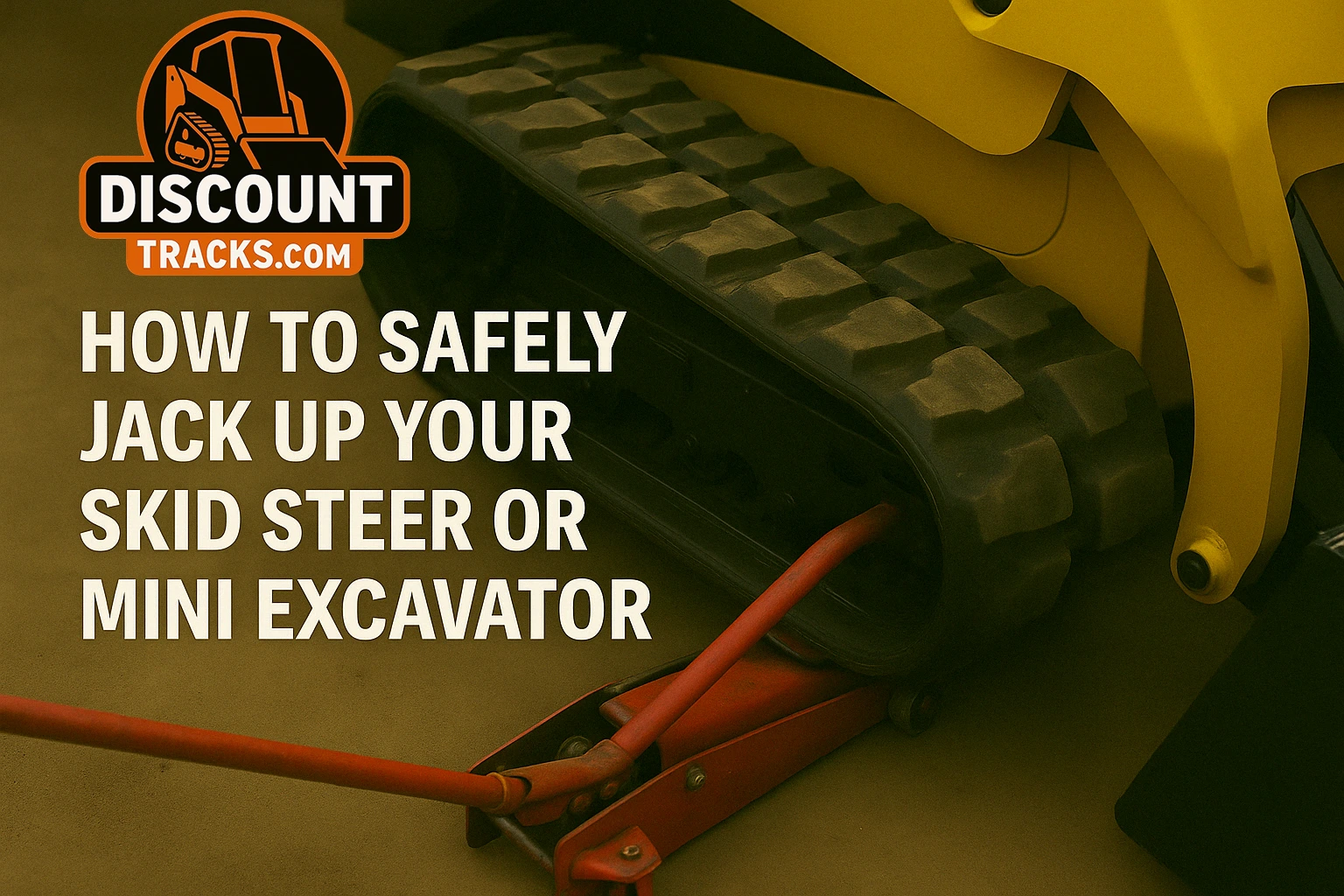Introduction
Lifting heavy equipment like skid steers and mini excavators is sometimes necessary for maintenance, but it’s one of the most dangerous tasks you can attempt without proper preparation.
If a machine shifts or falls off its supports, the consequences can be catastrophic—from severe personal injury or death to massive equipment damage. When it comes to lifting and supporting machinery, there is zero room for error.
This guide provides a thorough breakdown of how to safely jack up your skid steer or mini excavator, with a step-by-step emphasis on proper technique and support procedures. However, this is NOT a replacement for your machine’s official service manual. That manual is your safety bible.
Whether you’re performing track replacement, tension adjustments, or undercarriage inspections, mastering this foundational safety procedure is crucial for all safe equipment maintenance.
THE GOLDEN RULE: Your Operator’s Manual is Law!
Every equipment model has unique lift points, weight distribution, and safety procedures. Only your official operator or service manual contains the correct lifting and supporting instructions.
WARNING: Failure to follow your machine’s manual can cause serious injury or death. This guide offers general guidance but is NEVER a substitute for manufacturer instructions.
DANGER ZONE: Why Improper Lifting is So Risky
- Crushing Hazard: Equipment falling unexpectedly can kill or severely injure.
- Instability: Machines can shift or tip if lifted from the wrong point or uneven ground.
- Component Damage: Using the wrong lift points can bend frames or damage undercarriage parts.
- Hydraulic Failure: Jacks can collapse. They are for lifting ONLY, not long-term support.
Essential Gear for Safe Lifting & Supporting
1. Appropriate Lifting Device
- Tool: Heavy-duty floor jack or bottle jack rated well ABOVE machine weight.
- Why: Must handle the full lifting load without risk of failure. Only lift from approved points.
2. PROPER Supporting Devices (CRITICAL!)
- Tool: Jack stands (steel, high-capacity) or solid hardwood blocking.
- Why: Once lifted, you MUST support the machine securely.
NEVER use concrete blocks, bricks, or makeshift materials – they can crumble unexpectedly. NEVER work under a machine supported only by a jack.
3. Wheel Chocks (If Applicable)
- Tool: Heavy-duty chocks for wheeled models.
- Why: Prevent rolling before and during the lift.
4. Personal Protective Equipment (PPE)
- Tools: Safety glasses, heavy-duty gloves, steel-toe boots.
- Why: Protects from grease, pinch points, falling tools or components.
5. Your Machine’s Service Manual
- Tool: Official manufacturer manual.
- Why: Contains correct lift points, sequence, torque specs, and safety instructions.
Preparing for the Lift: Setting the Stage Safely
Step 1: Choose a SAFE Location
- Must be firm, flat, and stable. Concrete is best.
- Ensure ample clear workspace and lighting.
Step 2: Prepare the Machine
- Park on level ground.
- Lower attachments (bucket/blade) firmly to the ground.
- Engage parking brake, shut off engine, and remove key.
- Chock wheels (if wheeled).
- Ensure no bystanders are nearby.
The Lifting & SUPPORTING Process (General Steps – ALWAYS FOLLOW MANUAL!)
Step 1: Identify Correct Lifting Points (Use Manual!)
- Find frame locations approved for jack placement.
- Do NOT guess – incorrect placement can warp the frame or tip the machine.
Step 2: Position and Operate the Jack Correctly
- Center the jack securely under the approved lift point.
- Lift slowly and evenly until there’s just enough clearance to place supports.
Step 3: Place Jack Stands / Blocking IMMEDIATELY (The MOST Important Step!)
- Place supports under manufacturer-approved support points.
- Use at least two support points for stability.
- Make sure stands/blocks are level and stable, with full contact.
Step 4: SLOWLY Lower Onto Supports
- Lower the machine gently until fully resting on supports.
- Leave the jack in place lightly loaded if feasible, but NEVER rely on it alone.
- Gently push on the machine to confirm stability.
Machine-Specific Considerations (General)
Skid Steers
- Usually lifted via the main chassis/frame.
- Tracked and wheeled models may have different procedures.
- Use wheel chocks for wheeled machines.
Mini Excavators
- May require coordinated use of boom/blade and jacks.
- Manual will specify a precise lifting sequence.
- Often blocked at rear corners and under the blade or designated frame points.
Lowering the Machine Safely
- Clear the area beneath and around the machine.
- Reposition jack under proper lift point.
- Slowly raise just enough to remove jack stands or blocking.
- Remove all supports.
- Carefully lower to the ground.
Safe Maintenance Starts with Safe Lifting
Many maintenance tasks require lifting, including:
- Rubber track inspection/replacement
- Undercarriage cleaning
- Tension adjustment
To perform these tasks safely and effectively, mastering how to safely jack up skid steer and mini excavator equipment is a must.
Protect yourself, your equipment, and your investment with proper procedures and responsible safety habits.
Conclusion
Lifting a skid steer or mini excavator may seem simple, but it involves real danger. Always use rated lifting and support equipment, follow the exact procedures in your manual, and never work under an unsupported load.
Proper lifting keeps YOU safe and protects the long-term performance of your machine—especially critical components like your rubber tracks.
Work safe, always!
If you’re prepping for undercarriage or track work, ensure you’re using high-quality replacement parts. Discount Tracks provides reliable, long-lasting rubber tracks for all major equipment types.
Visit DiscountTracks.com or reach out to our experts for product guidance.
DISCLAIMER: This guide provides general safety advice only. ALWAYS defer to your machine’s official operator/service manual for model-specific procedures.


